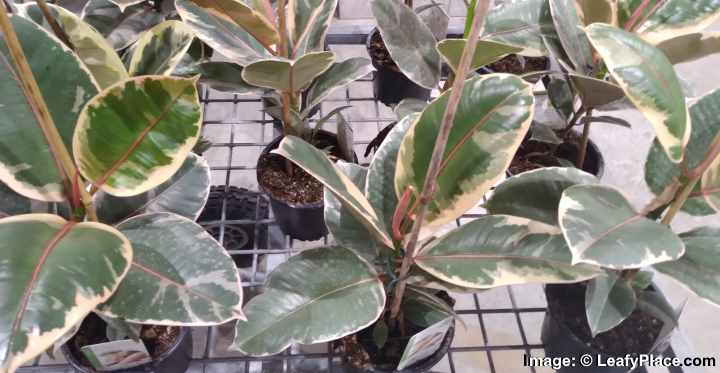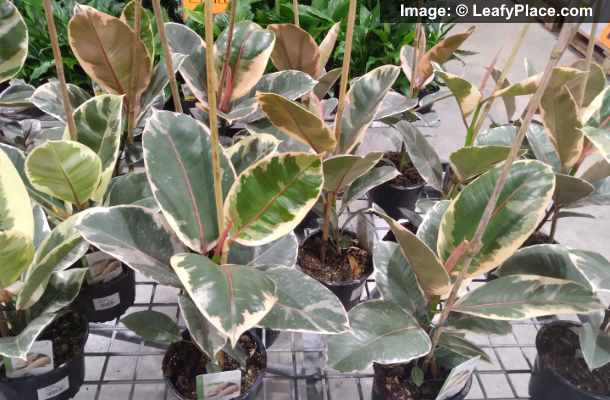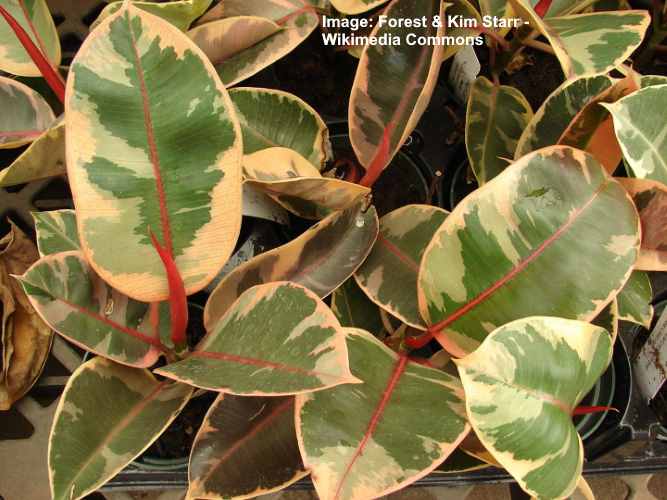Ficus Elastica Tineke (Rubber Tree Plant): Care and Growing Guide

Ficus elastica tineke is an attractive rubber tree plant with variegated green and creamy-white leaves. The main feature of ficus tineke is its large glossy, rubbery leaves that are dark green with yellowish or white edges and a tinge of pink. The advantage of growing this variegated rubber tree plant is that ficus tineke is an easy-care houseplant that thrives in most indoor environments.
This article is a comprehensive guide on how to care for Ficus elastica ‘Tineke.’ You will find helpful tips on ensuring that the variegated rubber tree houseplant thrives indoors.
How to Care for Ficus Elastica Tineke (Rubber Tree Plant)
To care for the Ficus elastica ‘Tineke,’ grow the rubber plant in bright light, protected from direct sunlight. Plant the ficus tineke in a well-drained potting mix and water when the soil partly dries. Keep indoor temperatures between 60°F and 75°F (15°C – 24°C) and average humidity. Fertilize once a month during the growing season.
Ficus Elastica Tineke Facts

ficus elastica Tineke
Ficus elastica ‘Tineke’ is a variety of rubber trees with variegated leaves. The ficus tineke is a cultivar of one of the 800 plants in the fig genus Ficus. Like all Ficus elastica varieties, the ‘Tineke’ houseplant has broad, oval leaves growing on a short stem.
Ficus elastica is a group of flowering plants originating in southeastern Asia. Ficus elastica is identified by its large shiny attractive leaves. In their native habitat, ficus shrubs and trees can grow between 50 and 100 ft. (15 – 30 m) tall. Although it flowers growing outdoors, a ficus rubber bush won’t bloom indoors.
Ficus rubber trees are tropical plants that grow outdoors in USDA zones 10 to 12.
Common names for Ficus elastica include rubber tree, Indian rubber fig, Indian rubber bush, and rubber fig. Ficus elastica is also on the list of plants said to bring good luck.
Ficus tineke is a relatively fast-growing plant indoors in ideal conditions. Growing in a pot, the rubber tree can grow between 1 and 8 ft. (0.3 – 2.4 m) tall. When it’s about 2 ft. (0.6 m) tall, the ficus is ideal on a table, windowsill, or shelf. When it grows over 3 ft. (1 m) tall, the plant is better as an indoor ficus tree.
There are several variegated Ficus elastica cultivars available like the Ficus elastica ‘Tineke’ rubber plant. For example, the Ficus elastica ‘Variegata,’ Ficus elastica ‘Starr,’ Ficus elastica ‘Tricolor,’ and Ficus elastica ‘Doescheri’ are all variegated rubber tree plants.
Ficus Tineke Leaves

Ficus elastica ‘Tineke’ variegated leaves are broad, leathery, glossy leaves with an oval shape and pointed tip. Ficus tineke leaves are 8” to 12” (20 to 30 cm) long and 4” (10 cm) wide. The light green shiny leaves have creamy margins with pink and red undertones.
A ficus tineke leaf starts out growing in a sheath that looks like a reddish-pink spike. The sheath gradually unfurls, revealing a green and creamy white leaf with a light green or pinkish underside.
Ficus Elastica Tineke (Rubber Tree Plant) Care Guide
Let’s look in more detail at how to grow the variegated Ficus elastica ‘Tineke’ as an eye-catching evergreen houseplant.
Light Requirements to Grow Ficus Elastica Tineke Indoors
Ficus elastica ‘Tineke’ grows best indoors in indirect bright light. Getting plenty of light is vital to ensure vibrant variegation of the thick, leathery green and cream leaves. Ideally, the ficus tineke shouldn’t get more than three or four hours of direct sunlight daily.
Too much direct sunlight exposure can burn the leaves, causing them to wilt and drop. However, a variegated ficus tineke isn’t a plant that tolerates low light. As a result, the stunning variegation will begin to fade in the continual shade, and the leaves will lose their creamy-white patterns.
Other signs that your ficus tineke isn’t getting enough light are leggy growth, slow growth, or sparse foliage on long, stretching stems.
The Best Potting Soil for Ficus Elastica Tineke Houseplants
Ficus elastica ‘Tineke’ thrives when grown in light, well-draining potting soil. An excellent soil mix for ficus houseplants is one part peat moss, one part pine bark, and one part perlite. This type of houseplant soil allows excess water to drain freely but retains enough moisture for the roots.
Ficus tineke rubber tree plants are adaptable to most types of soil. However, the crucial growing factor is fast drainage. A soggy potting mix or compacted soil will result in root decay and growth issues. You can tell if the soil drains poorly by how fast it flows through the pot and out the drainage holes.
Signs you need to amend or change your ficus potting soil include water pooling on the surface, poor water flow, or soft stems at the soil line. If you notice any of these signs, it’s time to change the soil to prevent root rot.
How to Water Ficus Elastica Tineke Plant
Typically, you should water a ficus tineke rubber plant once a week. However, before you water the tropical plant, check to ensure the top 1” to 2” (2.5 – 5 cm) of soil is completely dry. So, in hot weather, you might have to water a ficus every few days. But then water less frequently in winter.
Several factors affect how often you must water a tineke rubber tree. Here are a few tips on watering a variegated Ficus elastica:
- Warm temperatures cause moisture to evaporate faster, so you need to water more often.
- Tineke ficus plants growing in terracotta pots require watering more often than those in plastic pots. This is because the soil dries out faster.
- Seasonal changes affect ficus tineke watering. For example, in winter, growth is dormant, and the plant requires less water.
- Ficus rubber plants growing in larger pots tend to hold more moisture and require less watering.
- Always use filtered tap water at room temperature to water tropical plants like the variegated ficus tineke.
It’s good to remember that Ficus elastica ‘Tineke’ is relatively tolerant to drought. So it’s better to underwater a rubber tree rather than overwater. It is also easier to revive a ficus rubber bush that suffers from a lack of moisture than one standing in soggy soil.
Temperature Requirements for Ficus Tineke Houseplants
Ficus tineke grows best in consistent room temperatures between 60°F and 75°F (15°C – 24°C). The minimum temperature for a tineke rubber plant is 55°F (12°C). It’s also vital to remember that a sudden drop in temperature can cause the rubber plant to shed leaves.
When growing a rubber tree indoors, you should avoid the following conditions to ensure healthy foliage:
- Don’t place the cold-sensitive plant in a cold draft, air conditioning airflow, or near a drafty window.
- Avoid putting the potted ficus rubber tree near a hot radiator or furnace.
Ficus elastica ‘Tineke’ grows outdoors in USDA zones 10 to 12. If you live in a tropical climate, then plant a rubber plant in the ground where it gets dappled sunlight.
You can grow ficus tineke plants as container plants for balconies, patios, or deck areas during the summer in temperate climates. However, you must remember to bring the plant indoors when the temperature drops below 55°F (12°C).
How Much Humidity Does Tineke Rubber Tree Need?
Ficus elastica ‘Tineke’ grows well in average room humidity of 40 to 50 percent. However, a ficus tineke will grow faster in higher humidity. You could increase humidity for a rubber tree by growing it with other tropical houseplants, placing it on a pebble tray, or using a room humidifier.
Should you mist a variegated rubber plant? You can mist variegated ficus tineke leaves to clean them. After misting, wipe with a damp cloth to remove dust and dirt. But it’s good to note that misting has little effect on increasing humidity for a ficus rubber plant.
Top tip for ficus tineke care: if using a pebble tray half-filled with water to increase humidity, ensure the pot’s base doesn’t sit in the water if you want to avoid root rot issues.
Ficus Elastica Tineke Growth Rate
Ficus elastica ‘Tineke’ has a relatively fast growth rate and can average 24” (60 cm) per year. Growing indoors, a ficus tineke will mature at between 2 and 8 ft. (0.6 – 2.4 m), depending on pot size and indoor conditions. You should expect a healthy ficus tineke to produce a new leaf every four weeks or so.
How to Fertilize Potted Ficus Tineke Plant
Ficus tineke benefits from regular fertilization with a diluted balanced houseplant fertilizer. Apply a fertilizer diluted at half strength every four to six weeks during the growing season. You can also apply a slow-release fertilizer at the start of spring. However, hold off fertilizing during winter when growth is dormant.
It is vital to avoid applying too much fertilizer to a healthy variegated ficus tineke plant. A buildup of minerals and salts can cause root burn and negatively impact your plant’s growth.
How to Prune Ficus Elastica Tineke Rubber Plant
Pruning a ficus tineke in spring and summer encourages a fuller, bushier growth. You can cut off the primary branches just above nodes to create the shape and height you desire. New leaves will appear from cut nodes.
Propagating Ficus Tineke Plants
The best way to propagate a ficus tineke is by stem cuttings.
To grow a new plant, cut a 12” (30 cm) long piece of the branch just below a node and remove the lower leaves. Allow the milky sap from the cut stem to stop oozing. Dip the end of the stem in rooting hormone and place it in moist well-draining potting mix to root. Put in a bright, warm place for roots to develop.
It takes between 30 and 60 days for roots to appear. Once a propagated Ficus elastica ‘Tineke’ is established, you can transfer it to a 6” (15 cm) pot containing the appropriate potting soil.
How to Repot Rubber Plant — Ficus Elastica Tineke
Repot a ficus tineke variegated plant in spring when it has become root-bound, or when you need to refresh the potting soil. Typically, a ficus rubber plant needs repotting every two to three years. Transferring to a larger pot allows the roots more room to grow and promotes growth.
To repot a ficus tineke, remove the rubber plant from its container. Shake excess dirt from the roots and check for brown, mushy roots and remove as necessary. Next, put the ficus plant in a new, slightly larger pot and fill the pot with an aerated, well-draining potting mix. Then ensure the plant is growing at the same height as before.
After repotting the plant, water well and place in a bright spot protected from direct sunlight.
Is Ficus Elastica Tineke Rubber Plant Toxic?
The ficus tineke rubber plant is poisonous to cats and dogs. Scientists say that Ficus plants in the family Moraceae contain toxic compounds. In some countries, ficus plants are the leading cause of cat poisoning episodes. In addition, ingesting parts of ficus plants can cause gastrointestinal irritation in dogs, cats, and other small animals.
Pests Affecting Ficus Elastica Tineke Plant Growth
Common houseplant pests can affect variegated ficus tineke plants. Look out for spider mites, aphids, scale insects, and mealybugs. If you spot the signs of plant bugs, use a homemade neem oil pesticide to eradicate pests that infest rubber plants. You should also isolate the plant from your other houseplants.
To make a natural pesticide solution, combine 2 tsp. neem oil, 1 tsp. liquid dish soap and a quart (1 l) of water in a spray bottle. Spray the natural pesticide once a week, covering all the foliage, and leave it to dry. Continue using the neem oil spray until all signs of pests are gone.
It’s good to remember that a healthy tineke rubber plant growing in optimal conditions is usually resistant to pests.
Diseases Affecting Ficus Elastica Tineke Rubber Plant Growth
The most common disease affecting ficus tineke growth is root rot. To avoid a rubber plant having yellow leaves and mushy stems, only water the ficus when the soil partially dries. Never overwater a Ficus elastica if you want to avoid root decay.
What if your rubber tree shows signs of disease? The best natural remedy is to repot the plant in fresh, moist soil and remove all diseased parts of the plant. If root rot is extensive, your only chance to save the ficus from dying would be to take cuttings from healthy leaves and destroy the remaining plant parts.
Ficus Elastica Tineke Care — FAQs
Why are the leaves on my rubber plant turning yellow and falling off?
The most common reason for rubber plant leaves turning yellow, and dropping is overwatering. Too much soil moisture causes the roots to rot and decay. This starves the variegated ficus plant of essential nutrients, causing the leaves to turn pale yellow.
Another cause of yellowing Ficus elastica leaves is improper watering. Letting the soil completely dry out and then overwatering stresses the roots. As a solution, give ficus plants a thorough watering when the top 2” (5 cm) of soil is dry.
Will leaves grow back on a rubber plant?
Ficus tineke leaves don’t grow back after they have fallen off. Proper care like watering properly and keeping out of cold drafts help prevent premature leaf drop. New leaves on ficus plants grow from the top of the stalk. So, by pruning the plant’s height, you can encourage new leaves to grow.
It’s good to remember that leaves drop naturally as ficus houseplants age.
How do I know if my rubber plant is dying?
A few tell-tale signs that your rubber plant is stressed include yellow leaves, spots on leaves, leaf drop, and no new growth. To save a dying rubber plant, it’s vital to determine the cause of stress. So, make sure you’re watering the plant correctly. It is also crucial that the rubber tree isn’t in direct sunlight, drafts, or suffering from a lack of light.
How to make a variegated Ficus elastica rubber plant bushy?
Pruning is the best way to encourage bushy growth on a small indoor rubber tree. Cutting the stems just above the nodes stimulates new leaves and grows bushier foliage. You can also remove the top part of the stem, leaving only a few of the lower leaves if you want to create a bushier rubber plant.
Related articles:
